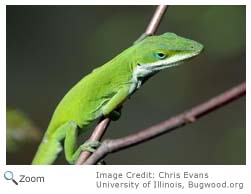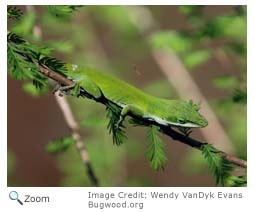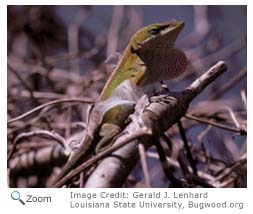Characteristics
 The green anole is five to eight inches in length. It has a sharp nose, a narrow head, a slender body and a long, skinny tail. It has pads on its feet that help it climb, run on and cling to lots of different surfaces. It has a white belly and lips, very long hind legs, and moveable eyelids. Its eyes can move independent of each other. The green anole is five to eight inches in length. It has a sharp nose, a narrow head, a slender body and a long, skinny tail. It has pads on its feet that help it climb, run on and cling to lots of different surfaces. It has a white belly and lips, very long hind legs, and moveable eyelids. Its eyes can move independent of each other.
 On most green anole, the eyes are surrounded by a thin turquoise border. The green anole is normally bright green, but it can change its color to brownish-green or dark brown in seconds. On most green anole, the eyes are surrounded by a thin turquoise border. The green anole is normally bright green, but it can change its color to brownish-green or dark brown in seconds.
It is sometimes call the American chameleon because it can change color, but it is not a true chameleon. The green anole changes color because of changes in temperature, humidity, health and mood, not to blend into its background. Males have a pink or red throat fan or dewlap.
Range
 The green anole can be found in the Southeastern United States from southern Virginia to the Florida Keys and west to Central Texas and Oklahoma. The green anole can be found in the Southeastern United States from southern Virginia to the Florida Keys and west to Central Texas and Oklahoma.
It has been introduced to Hawaii.
Habitat
 The green anole lives in habitats with very high humidity. It can be found in swamps, forests, wooded beaches and other areas with trees. It may also be found in parks and yards. The green anole is often found basking in the sun as it clings to trees, shrubs, vines, palm fronds, fence posts and walls. The green anole lives in habitats with very high humidity. It can be found in swamps, forests, wooded beaches and other areas with trees. It may also be found in parks and yards. The green anole is often found basking in the sun as it clings to trees, shrubs, vines, palm fronds, fence posts and walls.
|
|
Diet
 The green anole eats spiders, flies, crickets, small beetles, moths, butterflies, small slugs, worms, ants and termites. It only notices prey that is moving. It gets most of its water from the dew on plants. The green anole eats spiders, flies, crickets, small beetles, moths, butterflies, small slugs, worms, ants and termites. It only notices prey that is moving. It gets most of its water from the dew on plants.
Life Cycle
 The green anole breeds from March to September. The male will establish a territory and patrol it. He will attract females by puffing out his dewlap. He mates with females in his area and aggressively defends his territory from other males. The green anole breeds from March to September. The male will establish a territory and patrol it. He will attract females by puffing out his dewlap. He mates with females in his area and aggressively defends his territory from other males.
When a female and male mate, the female stores the sperm. If she doesn't mate with another male, the stored sperm will fertilize her eggs. The female lays a single egg and buries it in moist leaf litter, hollow logs or the soil. She will lay one egg every two weeks during breeding season. She may lay up to 15-18 eggs during the summer. The female does not stay with the egg or care for the young that will hatch in five to seven weeks. Young green anole eat small insects like mealworms, fruit and house flies and termites.
Behavior
 The male anole performs a series of visual displays to establish dominance and territory. To show dominance, it will bob its head up and down, do "pushups" and flare its dewlap. If it is threatened, it will also stretch out its throat, puff out its body, and turn sideways towards the threat. The male anole performs a series of visual displays to establish dominance and territory. To show dominance, it will bob its head up and down, do "pushups" and flare its dewlap. If it is threatened, it will also stretch out its throat, puff out its body, and turn sideways towards the threat. |